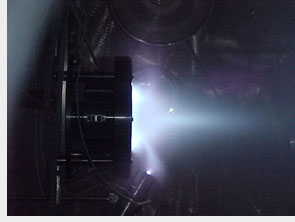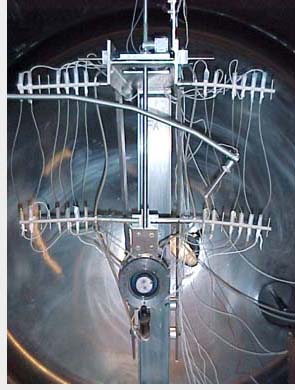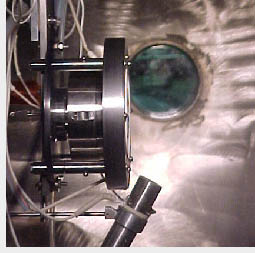


about theory
meetings
people
projects
publications
review
home
Plasma Thruster Physics
Present Studies | Development Activities
 |
To develop more efficient Hall thrusters for various space applications through better understanding of the physical processes involved in thruster operation.
Members of the Hall Thruster Project
| Research Support: | Dr. Nathaniel Fisch (Project Head) Dr. Yevgeny Raitses |
|
| Graduate Students: | Iliya Dodin Leonid Dorf Andrei Litvak |
|
| Undergraduate Students: | Kevin M. Ertmer Kai-Mei C. Fu Eugenio Ortiz |
|
| Technical Support: | Richard Yager | |
| Collaborators: | Prof. Amnon Fruchtman, Center for Technological Education, Holon, Israel Vlad Soukhanovskii, Dr. Dan Statman, Prof. Mike et. al Johns Hopkins University |
Research Objectives
- Control of spatial distribution of plasma parameters by using segmented electrodes in order to reduce beam divergence in the thruster channel and plume.
- Scaling of Hall thrusters to low (tens W) and high power (tens kW) levels.
- Control of plasma instabilities in crossed field plasma devices.
- Limitations of magnetic insulation in plasmas with magnetized electrons and non- magnetized ions.
- Interaction of high flux plasma jets with different targets (magnetic field, plasma and solid).
- Exploring of new configurations of crossed field plasma devices for space, scientific and industrial applications.
- Steady state electrical discharge in crossed field devices under various pressures and gases.
 |
- DOE
- LPDA
- AFSOR
A. TEST
- A 28 cub.m stainless steel vacuum vessel equiped with a 50,000 l/s (for air) pumping system.
- A 0.3 cub.m vacuum chamber equiped with 1500 l/s turbo pump.
- A few small vacuum chambers for different plasma experiments.
- Commercial voltage and current regulated power supplies (up to 1 kW and 10 kW).
- Commercial gas flow control and measurement systems.
- A high resolution thrust stand.
- Electrostatic probes and energy analyzer.
- Emissive spectroscopy.
- Digital and analog scopes and analysers.
 |
- The effect of segmented electrodes and their materials on ionization and acceleration processes in the laboratory Hall thruster at different power levels.
- The use of emissive spectroscopy for measurements of plasma properties inside and outside the thruster and for indirect characterization of the beam divergence inside the thruster channel.
- Scaling of Hall thruster geometry versus input power.
- Control of the location of a sonic transition point in Hall thrusters and its effect on thruster performance.
- Hall effect plasma acceleration in coaxial and non-coaxial configurations of cross-field devices.
- A breakdown and conditions for a steady-state electrical discharge in a crossed magnetic field with electronegative gases.
- Creation of magnetosphere storms.
- Modifications of configuration and materials of the segmented electrodes in a 2 kW Hall thruster.
- Micro Hall thrusters of coaxial and non-coaxial configurations.
- A probe setup for measurements of spatial distribution of plasma parameters inside the Hall thruster channel.
- A thrust stand and diagnostic for a micro thruster characterization experiments.
- An experimental setup for investigation of interaction of a high flux plasma jet with magnetic dipole.
- A plasma source for plasma etching.
Email Nathaniel Fisch or Yevgeny Raitses for more information on the Hall Thruster Project.
about theory | meetings | people | projects | publications | review | home
all content © Princeton Plasma Physics Laboratory